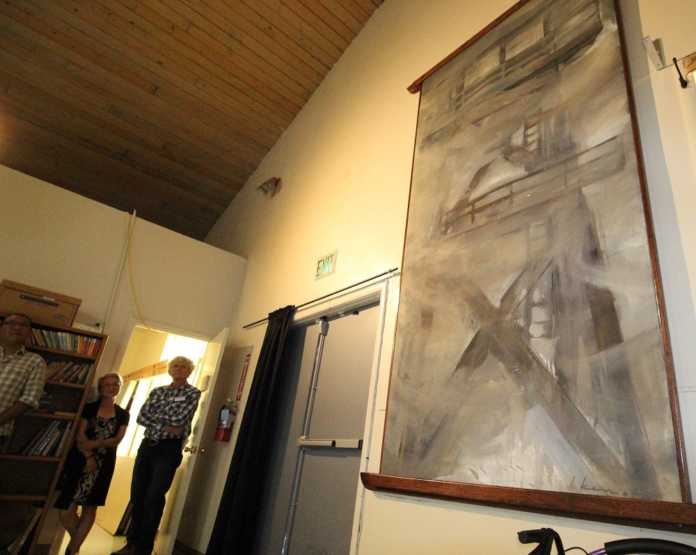(This painting of a World War II incarceration camp guard tower by Howard Ikemoto is now on permanent display at the Tokushige Kizuka Hall. Photo by Erik Chalhoub/Pajaronian)
WATSONVILLE — When Mas Hashimoto of Watsonville, who was uprooted from his home and sent to an incarceration camp with his family during World War II, learned that the U.S. government was considering granting every Japanese American internee $20,000 as reparation in the 1980s, he was initially against it.
Hashimoto said he thought it would “cheapen” the government’s apology to the Japanese Americans. But after hearing about an elderly Issei, a first generation Japanese immigrant, who was living in Los Angeles on a meager $5 a week for food, Hashimoto then realized that $20,000 wasn’t enough.
Hashimoto was one presenter during the Watsonville-Santa Cruz Japanese American Citizens League’s event Saturday commemorating the 30th anniversary of the Civil Liberties Act, signed into law by President Ronald Reagan on Aug. 10, 1988, which gave each surviving internee $20,000.
About 80,000 people received the checks, and nearly 10 of those were in attendance during the ceremony at the Tokushige Kizuka Hall on Blackburn Street.
“The apology enabled the beginning of the healing process,” said Watsonville-Santa Cruz JACL President Marcia Hashimoto.
Saturday’s event also marked the unveiling of Howard Ikemoto’s painting of a World War II incarceration camp guard tower, now on permanent display in the Tokushige Kizuka Hall.
Ikemoto, a retired Cabrillo College art instructor, now lives in Los Angeles, and was unable to attend Saturday’s event due to health reasons. Born in 1939 in Sacramento, Ikemoto and his family were incarcerated at the Tule Lake Camp in 1942, according to his friend and JACL member Sandy Lydon.

Watsonville-Santa Cruz JACL member Sandy Lydon speaks during the event. Photo by Erik Chalhoub/Pajaronian
“The climate at Tule was the most contentious, it was overcrowded, there were riots and there were tanks,” Lydon said. “That’s where Howard spent his childhood.”
The painting depicts a guard tower at Tule Lake Camp, located in Siskiyou County, shrouded in a dust storm the internees frequently encountered.
The Watsonville-Santa Cruz JACL purchased the painting last year. According to Marcia Hashimoto, the painting’s frame was designed by JACL board member Joe Bowes, who donated his time to craft it.
Also during the event, the short film “Days of Waiting” was screened, documenting the life of Estelle Peck Ishigo as she and her husband were incarcerated in the camps.
Lydon praised the work of the Watsonville-Santa Cruz JACL, which is the fourth largest JACL in the country.
The civil rights organization works toward justice and equal opportunities for all people, particularly important now when the U.S. government is separating children from their families at the Mexico border and enacting a travel ban for those from Muslim countries, he said.
“Mas and I can never stop; we cannot stop doing this,” he said of the JACL’s efforts. “There is a virus of racism that lies right along the spine of America.”











